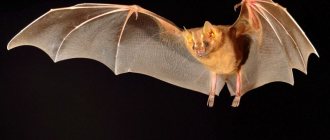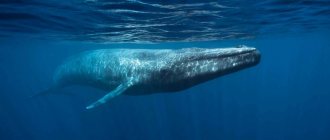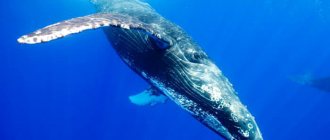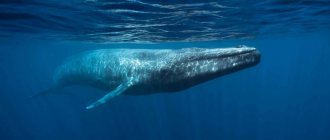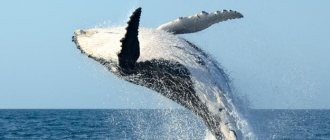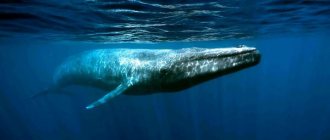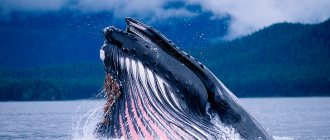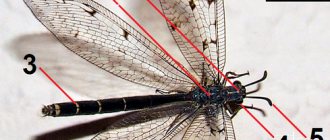The largest marine mammals are whales (kitos - translated from Greek as “Sea monster”). But the ancestors of whales were artiodactyl animals living on land.
Cetaceans look like large fish, but 1 of their ancestors is a hippopotamus!
Description
The largest whale in the world is blue, up to 25-33 m, and can weigh up to 150 tons. There are dwarf whales only about 6 m and up to 4 tons.
The whale's body shape resembles an elongated drop; they glide easily in the water. The eyes are small, and the nostrils are located at the crown of the head.
The structure of the teeth is different:
- Toothed whales have sharp, cone-shaped teeth.
- Baleen - without teeth, they filter water using bone plates (whalebones).
The whale's spine is elastic, due to which the animal is capable of any maneuvers. The large head smoothly blends into the body, tapering to the tail. And long flippers and a tail help it turn or brake sharply.
Note!
- Euthanasia of animals.
- Spitz. Features of the breed.
- Car hammock for dogs. What it is?
Baleen whales have whiskers on their faces and their bodies are completely smooth.
Whale whales also differ in color, from solid to spotted. As they age, marine animals can change their skin color. They have an excellent sense of smell, but taste is almost undeveloped. But they will distinguish salt water from fresh water.
Most whales are nearsighted, but have amazing hearing with a huge range from barely audible noises to ultrasound. Therefore, the whale ear has a complex structure.
The sense of touch is also excellent, thanks to the enormous number of nerves under the skin.
Classification
Toothed whales are divided into the following families:
- Gangetic dolphins ( Platanistidae
Gray, 1846) - Delphinidae ,
1821 - Narwhals ( Monodontidae
Gray, 1821) - Sperm whales ( Physeteridae
Gray, 1821) - Inii ( Iniidae
Gray, 1846) - Dwarf sperm whales ( Kogiidae
Gill, 1871) - Beaked whales ( Ziphiidae
Gray, 1850) - Laplatan dolphins ( Pontoporiidae
Gray, 1870) - Porpoises ( Phocoenidae
Gray, 1825) - River dolphins ( Lipotidae
Gray, 1846) - † Xenorophidae
Uhen 2008
There are several schemes according to which families of toothed whales are grouped into superfamilies. What is relatively certain is that dolphins, porpoises, and narwhals are closely related. They are sometimes classified as members of the superfamily Dolphinidae. However, the grouping of Laplatan, lake, Gangetic and ini dolphins into the superfamily of river dolphins is incorrect. Although representatives of all these families live in fresh waters, they arose and developed independently of each other. Sperm whales and beaked whales are very ancient families of toothed whales and are not closely related to any other family.
Whale lifestyle
Cetaceans communicate using echolocation. The layers of fat in the skull act as a sound lens.
Note!
- Removal and cremation of animals
Cynologists - who are they?
Car soundproofing. What is she like?
The whale's movements are slow, but sometimes give way to a big race of up to 40 km/h. They are warm-blooded, but the water temperature is not important; a thick layer of fat is an excellent protection against hypothermia.
The huge volume of the lungs allows animals to be under water for up to 1.5 hours. When it floats to the surface, it releases a tall fountain when it exhales. This is a whole sheaf of condensate, often accompanied by a “pipe hum”.
Small whales live about 25-30 years, and large whales live up to 50 years.
Natural enemies
The main factors of whale mortality include active fishing. However, some severe parasitic diseases are also common for cetaceans. Cetaceans often develop debilitating skin diseases, including ulcers, fungal infections, and malignant pimples. Whales are also affected by skeletal diseases and severe bone tumors or exostoses, complex bone growths or synostoses.
A large mammal may suffer from periostosis, curvature of the jaws and some dental diseases, muscle pathologies, tumors and lung abscesses, purulent pneumonia, cirrhosis of the liver, gastric ulcers and stones in the ureters, contact infectious diseases, including erysipelas or erysipeloid.
A number of dolphins and smaller whales die in fierce battles with killer whales. Significant damage to the general population is also caused by various parasites, represented by trematodes, cestodes and nematodes. The most common ectoparasites in whales include barnacles and so-called whale lice.
Return to content
Species of whales
Blue whale
The largest blue whale on the planet, up to 33 m long and weighing up to 150 tons. Marbled skin with grayish spots. Its food is small fish and plankton.
Cetaceans migrate alone. When they get scared or are seriously injured, they descend to the bottom to 550 m. Although healthy people dive only to 100 m.
A whale spends 3/4 of its life underwater. The female gives birth to 1 baby every 2-3 years.
The blue whale is a long-liver, capable of living 80-100 years.
Humpback whale
The fin resembling a hump gave it the name “humpback”. The body is gray-black with sparse spots, up to 14 m, weighs about 30 tons, is distinguished by growths on the top of the head (warts) and the belly is white.
They feed on mollusks, crustaceans and small fish. The humpback whale makes the loudest sounds, pleasant to the ear. Lives up to about 50 years.
Dwarf whale
A very rare whale - a dwarf one. It is slightly less than 3 tons and up to 6 m long. It has a smooth gray-black body. The pectoral fins are small, and the dorsal fin is up to 25 cm in the shape of a sickle.
A distinctive feature of this species is that it has a white-yellow whisker.
It is difficult to meet because it is not visible above the water. This whale does not make a rumble and produces a small fountain. He swims slowly, bending his body with a wave.
Important! Loves solitude, found among minke whales and sei whales. It is recognized by a white spot on the jaw (gums).
Sperm whale
A striking representative of cetaceans is the sperm whale. They live in herds, diving deep into the ocean.
The animal's large supply of air is stored in the air sac, also in the muscles. Communicates with relatives using ultrasounds.
A wounded sperm whale is dangerous due to its aggressiveness and is capable of sinking a whaling ship. Due to hunting, the animal population has declined sharply.
It feeds on crustaceans, squids, small sharks, mollusks, etc.
Reference! The sperm whale is the only mammal that can accommodate an adult human in its mouth. When ships crashed, sperm whales swallowed people.
Belukha
This is a toothed whale, due to its white color it received the name “Belukha”. They live up to 40 years and have oval-shaped pectoral fins.
Babies are born dark blue. Adults have a huge, prominent forehead. A unique ability among whales is to turn their heads.
Killer sperm whales and Leviathan himself
In the early Miocene, about 20 million years ago, sperm whales (Physeteroidea) appeared. Nowadays they are specialized squid hunters. However, some Neogene sperm whales were the killer whales of their time, occupying the ecological niche of killer whales until their appearance about 3 million years ago. The name "killer sperm whale" in the scientific literature was given to Zygophyseter varolai
) from the Late Miocene of Italy, 10–7 million years ago [].
This whale was 6–7 m long, with a powerful skull and numerous large teeth in the upper and lower jaws. Other killer sperm whales were also formidable predators: the seven-meter-long Brygmophyseter shigensis
from Japan (age 15–14 million years ago) and representatives of the genus Acrophyseter
from
Peru (9–6 million years ago), reaching only 4 m in length, but also occupied the niche of active sea hunters [].
Remains of a much larger marine predator have also been discovered in Peru, dating back 10–9 million years ago. The giant killer sperm whale reached 18 m in length and weighed about 40 tons (about the same as the males of a modern sperm whale). The length of its skull is about 3 m, and its teeth have a diameter of about 12 cm and a length of up to 36 cm. Perhaps these are the largest teeth in the animal world, not counting hypertrophied fangs and tusks. The colossus was called "Melville's Leviathan" ( Livyatan melvillei
), in honor of the biblical monster Leviathan and the American writer Herman Melville, author of the novel “Moby Dick, or the White Whale”. It can be assumed that the appearance of such large predators was associated with the development of gigantism among their potential victims - baleen whales.
Whale breeding
Animals reach maturity by 12 years, but are ready to breed by 4-5 years. Males have a prolonged mating season and can mate frequently.
Depending on the type of animal, pregnancy takes 7-15 months.
In winter and during childbirth, females migrate south to warm waters earlier than males. They stay there with newborns, and in the summer they remain in temperate latitudes.
The baby whale is born tail first and swims near the female. Whale milk is the fattest.
Huge sea animals, conquerors of the oceans, decorate our planet. Nowadays, catching and hunting of cetaceans is prohibited in different countries to increase their numbers.
The photo shows whales of different species.
[edit] Security and status
All species included in the suborder, with the exception of the dwarf whale, are potentially valuable commercial animals capable of producing a large amount of useful products, most of which is fat used in the medical, food and other industries. Meat can be used to produce feed flour and fertilizers, and also as a food product. The liver of many species of whales contains large amounts of vitamin A, and the endocrine glands can provide raw materials for the manufacture of medicinal drugs.
The uncontrolled extermination of baleen whales has not only led to a strong decline in numbers, but has brought them to the brink of catastrophe - almost complete extinction. All species of baleen whales are included in the IUCN Red List and in Appendix I of the Convention on International Trade in Endangered Species of Wild Fauna and Flora.
In a number of countries, fishing for some baleen whales continues, mainly for the needs of the local population.
Human influence
Sperm whales have been intensively hunted for a long time. Currently, hunting is only allowed for some small whales, such as pilot whales, but most whales face the threat of fishing nets, in which they become entangled and die, unable to surface for air. Especially when catching tuna in nets, thousands of dolphins die.
Keeping such small whales as dolphins, killer whales or beluga whales is a great attraction for tourists in zoos and oceanariums. Due to the great need for space of these animals, keeping them is usually very difficult.
Video
Origin
Whales presumably descended from artiodactyl terrestrial mammals, which switched to a semi-aquatic lifestyle about 50 million years ago.
There are different theories about the origin of whales. Whales, dolphins and porpoises were thought to have descended from a group of land mammals called mesonychians. These creatures looked like wolves, but had hooves like cows and deer. They lived approximately 60 million years ago around the ancient Tethys Sea, in what is now the Mediterranean Sea and part of the Asian subcontinent. Mesonychia probably hunted fish and other aquatic animals in coastal swamps and estuaries. As they spent more and more time in the water, their bodies began to change. They became more streamlined and developed powerful, flattened tails. Their forelimbs gradually turned into fins, and their hind limbs degraded. A thick layer of subcutaneous fat appeared, and the hair began to disappear. To facilitate breathing from the surface of the water, their nostrils moved to the top of their heads and gradually turned into blowholes.
Recent studies have shown that the connecting link was the genus Indohyus, which lived in Pakistan and looked like modern deer. During the Eocene, the ancestors of whales gradually adapted to life at sea, filling the ecological niche that was vacated after the extinction of mosasaurs and plesiosaurs. Over time, they lost all connection with land and acquired new adaptive characteristics, losing features characteristic of terrestrial mammals.
Deathmatch
Zoologists call the deadly fights of sperm whales with giant squids one of the most striking spectacles of wildlife. This explains the scars and sucker marks that literally litter the largest toothed whale. In a mortal fight, squids defend themselves by leaving marks on the whale’s head in the form of small depressed circles with a diameter of 25 cm. There is a known case when a half-dead squid weighing 200 kg was removed from the stomach of a sperm whale! Curiously, its tentacles protruded from the mouth of the toothed whale, firmly attached to its rectangular and large head. Entire legends and stories are already circulating about the eternal confrontations between squid and sperm whales. That's how warlike he is - this sperm whale! A photo of the deadly fight is presented below.
Nutrition
All representatives of toothed whales, unlike baleen whales, feed on piece prey. Grasping prey is often combined with suction, which allows them to pull several fish or shellfish into their mouths at once. Their food is fish, cephalopods and crustaceans.
Most toothed whales are excellent hunters. They often hunt in groups, surrounding their prey, much like lions or wolves do. There are cases when a group of killer whales successfully hunted a polar bear and even a blue whale.
Almost all toothed whales are fast swimmers, due to their feeding habits. Some are capable of deep and prolonged immersion.
